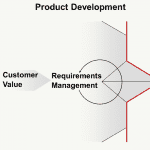
While previous articles focused on requirements writing, another element of products requirements is design constraints.
A design constraint might not be a requirement in the purest sense, but must be accommodated in product requirements (and, ideally, identified as such). Design constraints almost always make their way into product requirements.
Let’s use a simple example whereby a specific housing material is specified (a polyester thermoplastic elastomer).
The requirement might simply be: “The housing material shall be made of a polyester thermoplastic elastomer”. The PRD is then provided to the designer, essentially telling him he must use this material.